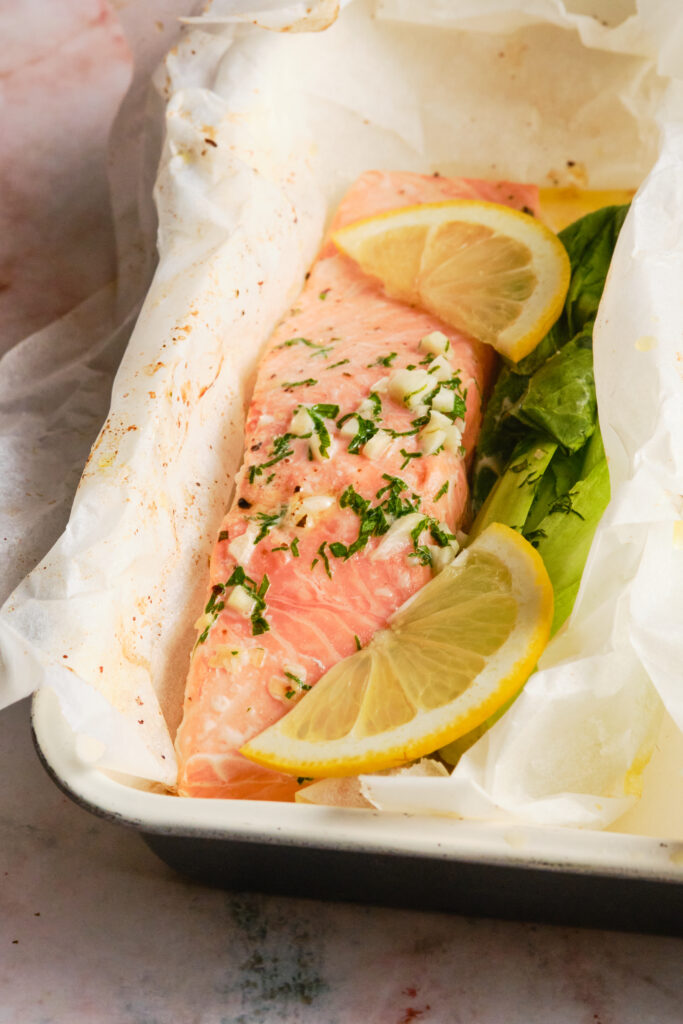If you want to make tasty and healthy Baked Salmon at home, get some parchment paper. It will help keep all the lovely flavors inside.
Few recipes call upon paper to play as vital a role as this recipe for Baked Salmon does. This recipe is simple and classy, just like me! It’s a great way to make sure you and your guests have a memorable meal. The paper makes sure that the salmon is cooked slowly enough to be tender, juicy, and perfectly seasoned. You won’t have to spend hours cooking either, which makes it a great choice for busy weeknights, small dinner parties, or even a fancy feast.
The parchment paper acts like a container that keeps all the flavors in and steams the food until it’s ready to eat. I won’t get too technical, but that’s the point. If you cook the salmon and pak choi in paper, you won’t have to clean up. Just roll up the mess and throw it away (Grilled Salmon, I’m looking at you). You’ll be able to spend more time with your guests and not in the kitchen slaving over pans with caked-on fish if you serve the fish and pak choi in the paper as directed. Your guests will love the unique presentation.
I’ve listed two fillets and two pieces of pak choi in this recipe. The idea is that each person gets one. If you need more, just increase the amount.
Wrapping salmon in parchment paper, also known as cooking en papillote is one of the easiest and most foolproof ways to cook fish. The parchment seals in steam which gently cooks the salmon, keeping it incredibly moist and tender. The paper also traps in all the aromatics like lemon, herbs, and wine infusing the salmon with tons of flavor. This simple technique delivers restaurant-quality salmon every time with very little effort. Here’s everything you need to know about how to wrap salmon in parchment for the perfect texture and taste.
Benefits of Cooking Salmon in Parchment Paper
There are several reasons why parchment paper is ideal for cooking salmon fillets
-
Moist and tender salmon: the steam inside the parchment packet cooks the fish slowly and evenly on all sides. This keeps the salmon very moist and makes it easy to flake when it’s done. No more dry, overcooked salmon!.
-
Infused with flavor Any aromatics like lemon, herbs garlic, or wine steam right along with the salmon permeating it with their flavors.
-
Easy cleanup: Salmon cooked in parchment makes for no-mess cleanup. No splattering grease or strong fishy smells. Just throw away the parchment and wipe down the pan.
-
Quick cooking: Salmon fillets steam in parchment in just 10-15 minutes. It’s a fast weeknight dinner solution.
-
Healthy: Cooking en papillote requires little to no added oils or butter, keeping it light. Let the salmon’s natural oils and moisture do the work.
-
Impressive presentation: bring the whole parchment packet to the table and let each person open their own to let the smell out. It’s fun, interactive, and elegant.
How to Choose the Right Salmon for Cooking in Parchment Paper
Fits about an inch thick work best for salmon because thinner pieces cook too quickly and thicker cuts don’t cook all the way through. Look for fillets that are evenly thick all over to ensure even steaming. It’s best to cook salmon without the skin because the skin can get tough and soggy when steamed instead of crispy when seared at high heat. Skinless center-cut fillets are ideal.
For a flavor boost, choose wild salmon over farmed. Wild salmon get their pink hue from eating krill and shrimp that infuse their flesh with more Omega-3s, resulting in a richer, more complex flavor.
Parchment Paper vs. Foil for Cooking Salmon
You can use parchment paper or aluminum foil to make your salmon packet. Most chefs prefer parchment paper because:
-
It’s nonstick so the salmon won’t cling to it like foil.
-
Parchment paper won’t impart a metallic taste like foil can.
-
It’s more environmentally friendly and compostable unlike foil.
However, foil does conduct heat more efficiently if using a grill or campfire vs an oven. For oven cooking, parchment paper is best. Look for oven-safe parchment paper that can withstand high temps.
How to Fold Parchment Paper for Cooking Salmon
Here are step-by-step instructions for folding salmon in parchment paper for perfect results:
-
Cut a piece of parchment large enough to fully wrap your salmon fillet and veggies. About 12×16 inches is a good size.
-
Place the seasoned salmon fillet on one half of the parchment. Top with sliced lemon, herbs, veggies etc.
-
Fold the empty half of the parchment over the salmon stack and align the edges.
-
Starting at one end, make small overlapping folds along the open sides, crimping the paper together and sealing it tightly.
-
Make pleats as you continue crimping the parchment shut into a half moon shape.
-
Twist the pointed end for a fully enclosed pouch. Make sure the packet is tightly sealed.
-
Bake salmon packet seam-side up on a baking sheet at 400°F for 10-15 minutes until opaque and flaky.
-
Let the packet rest for 5 minutes before carefully opening to allow steam to escape.
Ideal Pairings for Salmon En Papillote
Some delicious aromatics to pair with salmon in parchment include:
-
Lemon – Bright acidity cuts the richness of salmon. Use thinly sliced rounds.
-
Herbs – Fresh soft herbs like dill, parsley, basil, cilantro pair wonderfully.
-
Shallots – Minced shallots add a sweet oniony flavor.
-
White wine – A splash of white wine steams beautifully.
-
Veggies – Thinly sliced zucchini, potatoes, tomatoes, spinach, asparagus.
-
Salt, pepper, olive oil – Light seasoning lets the salmon shine.
Get creative with your own favorite flavors! Anything steamable works.
Step-by-Step Recipe for Baked Salmon in Parchment Paper
Now that you know the technique, give this easy recipe a try:
Ingredients:
- 2 (6 oz) salmon fillets
- 2 tbsp olive oil
- 1 lemon, thinly sliced
- 1 shallot, minced
- 1 garlic clove, minced
- 5 sprigs fresh dill
- Salt and pepper to taste
Directions:
-
Preheat oven to 400°F. Cut two 12×16-inch pieces of parchment paper.
-
Place salmon fillets on each parchment piece. Drizzle with olive oil and top with lemon slices, shallot, garlic, and dill.
-
Season with salt and pepper. Fold over parchment and crimp edges to seal.
-
Bake packets on a baking sheet for 12-14 minutes until salmon is opaque and tender.
-
Remove from oven, let rest 5 minutes before opening packets. Serve salmon in parchment with pan juices.
The beauty of cooking salmon in parchment paper is you can customize the aromatics however you like. Simply ensure the packet is tightly sealed before baking for maximum flavor infusion. In just minutes, you’ll have restaurant-quality salmon easily achievable at home. Give this foolproof technique a try for your next impressive – yet effortless – dinner!
Common Questions about Cooking Salmon in Parchment Paper
How long should you bake salmon in parchment paper?
For a 1-inch thick salmon fillet, bake at 400°F for 10-15 minutes. Thinner fillets may take less time, thicker cuts can take 15-18 minutes. Check for doneness by opening the packet slightly to peek inside. The salmon should be opaque and flake apart easily when ready.
Can you cook frozen salmon in parchment paper?
No, parchment packets work best with thawed, fresh salmon fillets. The slow steaming method doesn’t allow frozen salmon to cook through properly. Defrost salmon first before wrapping in parchment.
What happens if you don’t seal the parchment paper?
An unsealed packet won’t build up steam, so the salmon will dry out and won’t pick up as much flavor. Make sure to crimp the edges tightly for the ideal texture and taste.
Is foil just as good as parchment for salmon?
Foil can work but may impart a metallic taste. It also can stick to the salmon. Parchment paper is ideal for its nonstick surface, neutral taste, and environmentally friendly properties.
Can you grill salmon in parchment paper?
Yes, you can wrap salmon in a parchment pouch then grill it indirectly, off the hot grates. The packet should be loosely sealed as increased steam can burst the pouch on the grill. Grill over medium heat, turning the packet frequently.
What side do you cook the salmon on in parchment?
Place salmon skin-side down so the presentation side gets nicely steamed. Put aromatics on top of the salmon before folding over the parchment. The skin helps separate the fish from the parchment.
Can you reuse parchment paper for cooking salmon?
It’s best to use fresh parchment for each use. Reusing paper that previously cooked fish can result in odors transferring to the new food. Parchment is inexpensive and compostable.
Enjoy Restaurant-Worthy Salmon at Home
Cooking salmon in parchment paper seals in moisture and flavor for fabulous results with minimal effort. Follow the folding technique, add aromatic ingredients like lemon and herbs, bake, rest, open, and impress your guests as you serve salmon en papillote. This simple trick elevates a weeknight staple into a gourmet dish!

How To Store Baked Salmon In Paper
After the salmon cools, store it airtight without extra sauce. In the fridge, it’ll last three days – in the freezer, a whopping three months.
To reheat, let refrigerated salmon rest then warm gently. Thaw frozen salmon in the fridge overnight, then heat up low temp or steam it.
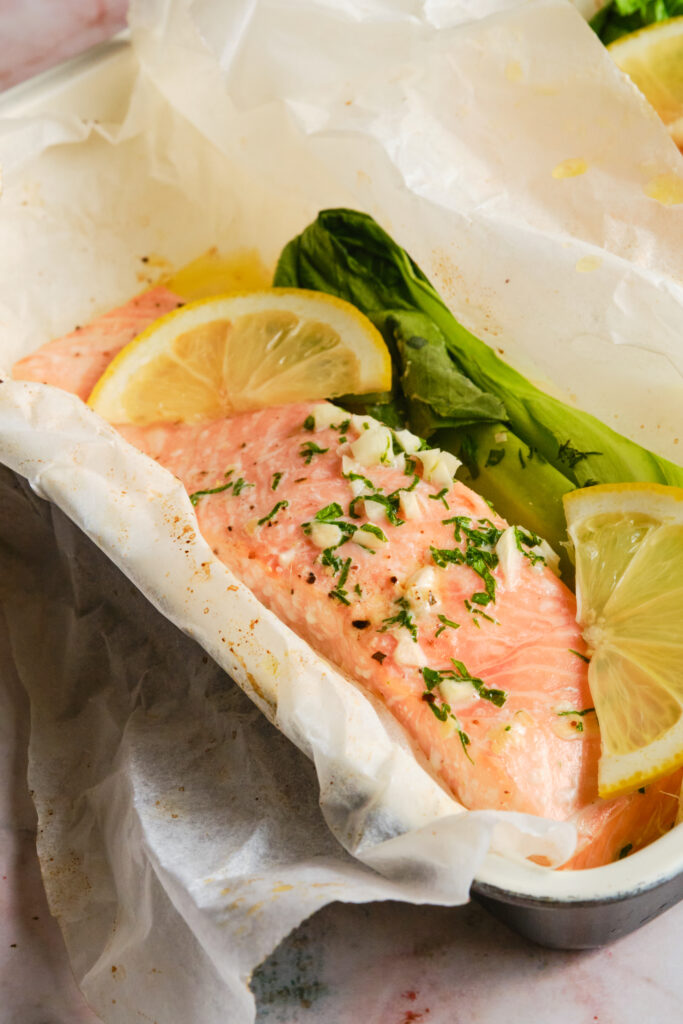

How to Make Salmon In Parchment Paper – The Steps
Step 1: Preheat the oven to 425°F and prepare 2 sheets of parchment paper packs. Lay them separately on a baking tray. In a small bowl, combine the broth, lemon juice, minced garlic, and chopped parsley.

Step 2: Season both sides of the salmon with salt and pepper. Drizzle the broth mixture over the salmon fillets. Place together the pak choi inside the parchment paper packets.
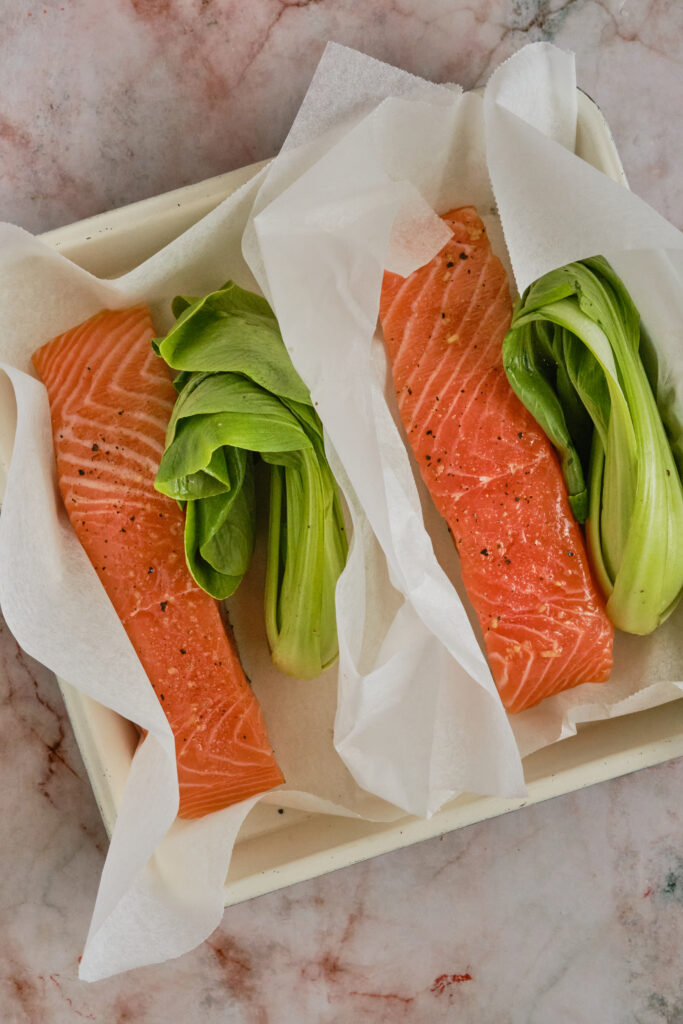
Step 3: Divide the butter cubes over the salmon fillets and pak choi. Wrap up the paper packets in and fold the edges together.

Step 4: Put the salmon paper packs on the baking sheet that has been prepared. Bake them in a hot oven for about 10 minutes, or until the salmon and pak choi are cooked.
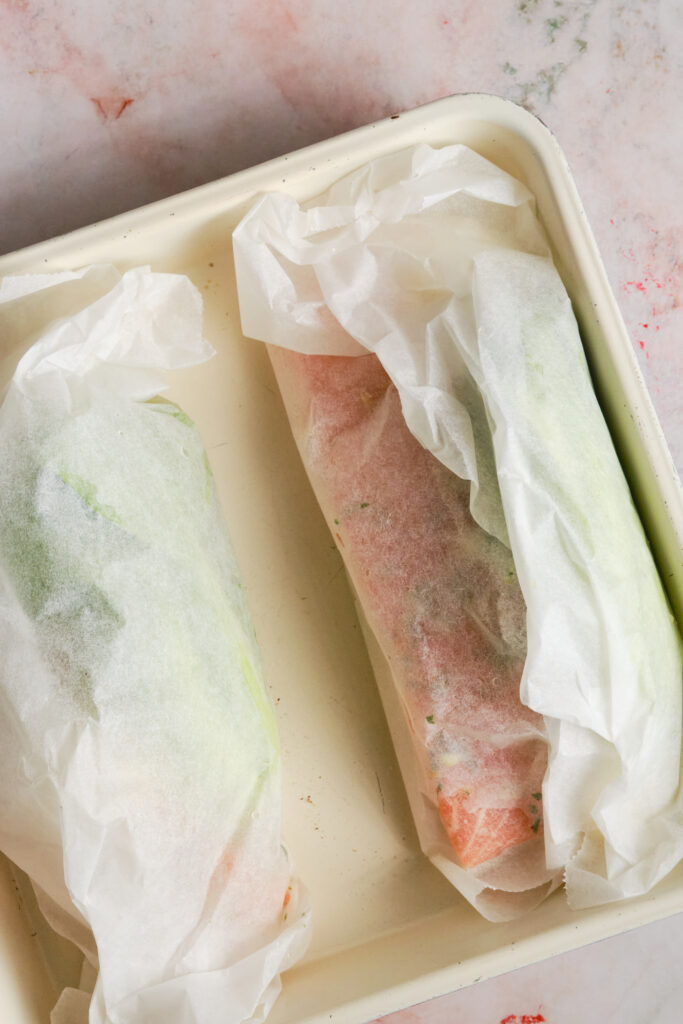
Step 5: Carefully unwrap the parchment paper packets and garnish with some fresh parsley and lemon slices. Enjoy!
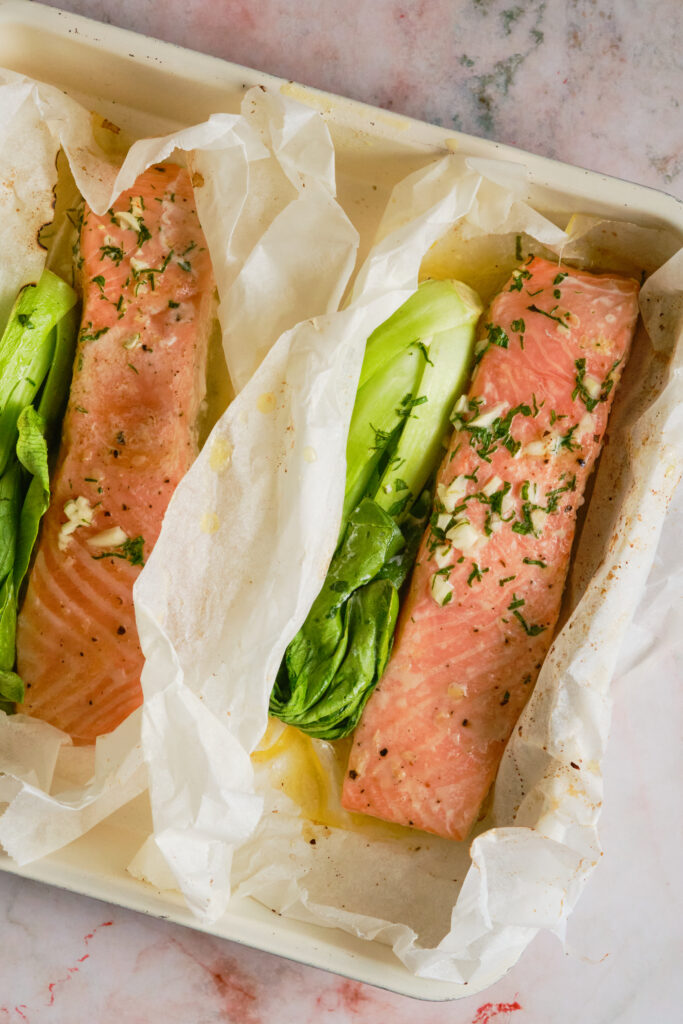
- Take soy sauce, lime juice, and a little honey and mix them together to make an Asian-style marinade.
- You can also play with a bunch of spices and herbs. Trust me, dill, chives, tarragon, thyme – they all sing. If you like your food spicy, add a few shakes of red pepper flakes. Change the oranges or limes for a fun citrus twist. This one can go in any direction you want.
- Add olives, cherry tomatoes, and feta cheese to your salmon. If you love Mediterranean food, you’ll be crazy about this. You just took your salmon on a short trip to the Mediterranean.
- Let the salmon soak in the marinade for thirty minutes to an hour. It’s kind of like a spa day for your fish, and I promise it was worth the wait.
- Wrapping the parchment paper is key. You want a nice, tight package that keeps all the steam and moisture inside. It’s kinda like gift wrapping, but way tastier. This makes salmon that is cooked just right and full of juicy meat.
- Perfectly cooked salmon clocks in at 145°F. Remember that some fillets may be different and need a little more or less time in the oven than what my recipe calls for. Just keep an eye out and you’ll be golden.
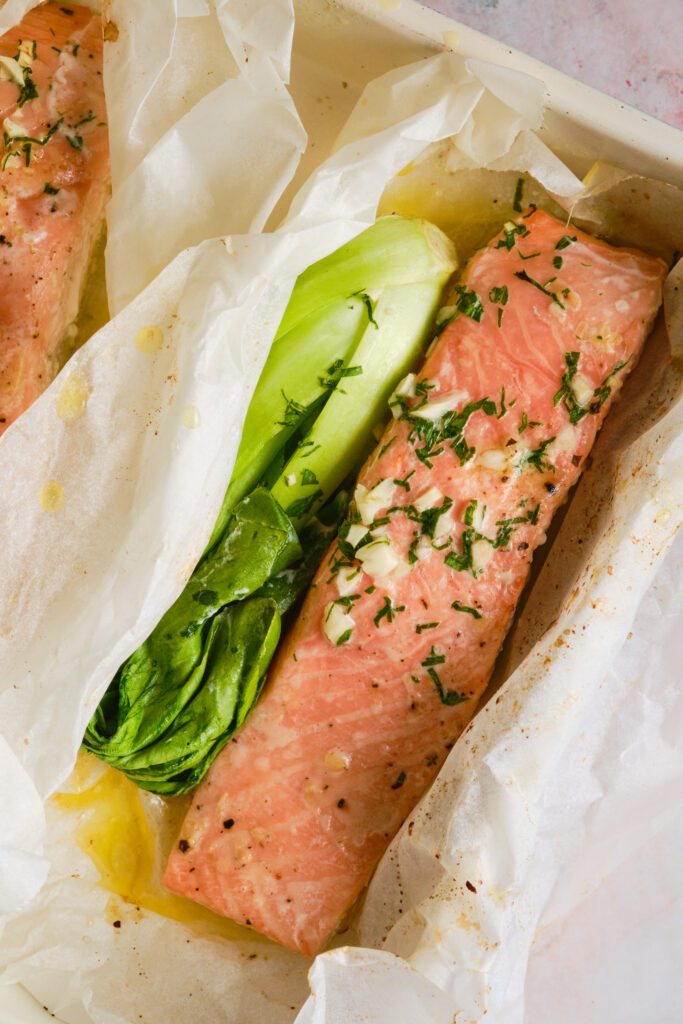
To complete your meal, pair your baked salmon with complementary side dishes. Steamed asparagus, roasted vegetables (like my Brussels sprouts recipe), scalloped potatoes, quinoa, lightly seasoned rice, or a fresh mixed greens salad have all worked well for me. The options are endless, and you can mix and match according to your mood!.
You could, but for this recipe, I think parchment paper would work best so the fish cooks evenly.
It really depends on your own tastes (and what you can find at the store). Just be sure that your salmon has a good color, firm texture, and a fresh scent. If it’s discolored, slimy, or has a strong fishy odor, move on.
Frozen will still do the trick. Thaw the frozen salmon fillets overnight in the fridge first and make sure the salmon is thoroughly defrosted. Also, I recommend patting it dry before cooking.
You can use any other green leafy vegetable, like spinach, Swiss chard, fennel or baby bok choy. If the vegetable you choose has a similar cooking time to pak choi, you won’t have to change the cooking time.
